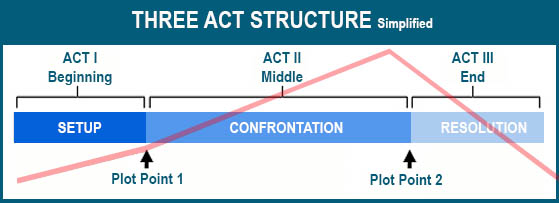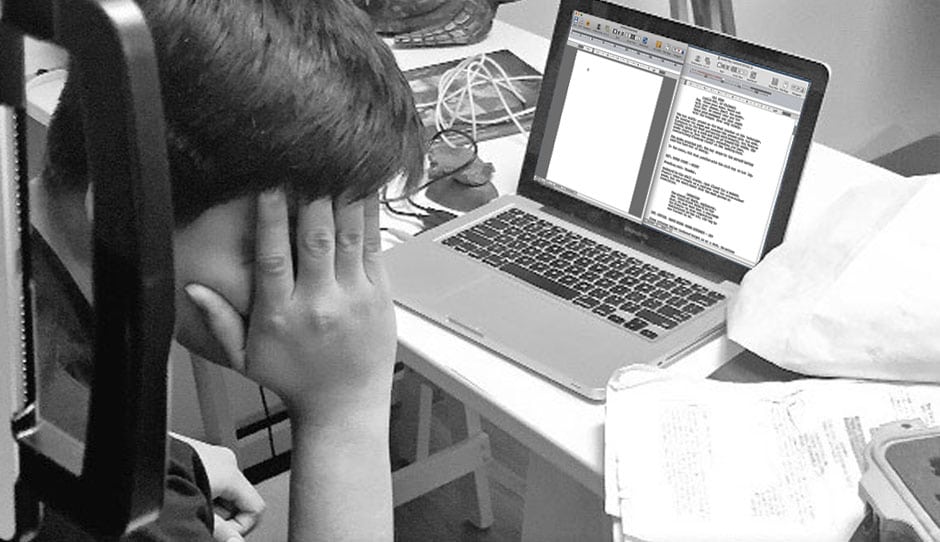If you have trouble shaping your film’s concept into a narrative, think of how your screenplay should be structured and what you’re trying to say. If we still can’t get to the end of the story – that’s likely a structural problem.
Contributed By Glen Berry, Edited by Stavros C. Stavrides
Important Concepts
- Start with a premise
- Do your Research
- Structure Clarifies the Concept
Although there are different schools of thought on the sections in a story, we will be discussing Aristotle’s Three Act Structure. This structure dictates that every story has three acts: a beginning, middle and end. I know this sounds elementary but each act has particular properties.
This structure can be described with a diagram called The Dramatic Curve.

The Three Acts
In the First Act, the main character, or protagonist, is introduced and the location is set. This description of the character and the setting is called Exposition.
Bridging the First and Second Act, the protagonist is confronted with some kind of obstacle. The presentation of this obstacle, or conflict, is the inciting moment or incident.
This second act is mainly comprised of the protagonist’s attempts to overcome this obstacle. The protagonist cannot accomplish their objective easily, for if they did, there would be no story. Complications arise, and tension increases as the protagonist attempts to overcome this obstacle. This rising action is what drives our story forward.
The Third Act contains the climax of the story, where this conflict is resolved and final obstacles overcome. If the story works out in favor of the protagonist, it is comedy. If it works out against the protagonist, it is a tragedy. Denouement is a French term that literally translates to the unravelling of a knot. In the denouement, we see the aftermath of the resolution and how it affects the characters in the story.
It is in the resolution of this conflict that we find whatever it is that we are trying to say. Most times, writers have difficulty with how their story ends. They may have an interesting setting or conflict but it is in the resolution that we find the content of the story. If you do not know how the story ends, you do not know your story.
This post is a support article from Cyber Film School’s
Multi-Touch Learning System, 2022 Edition
Contract With Your Audience
What do we want the audience to leave the theater with?
We do not have to create works that will change the world but we should know what idea we want to put forward. It doesn’t really matter what the content is of the story you decide to make but you do have an obligation to tell a story.
You cannot ask the audience to sit and spend time with you if you do not deliver something that will engage them. You have a contract with the audience. They spend time with you, you will entertain them. The subject matter can be serious, it can be odd, it can be comic, or it can be sad. It doesn’t matter what it is but you must deliver.
You must say something or you are wasting your time and energy.
Find an idea that intrigues you and then find what about it is important to you. Then you can build a story around communicating that idea to others.
Summary
• The concept of your screenplay should be reducible to a few sentences. Without this clarity, you cannot build a story.
• Invest time in determining how your concept is different from others and how it might be the same. This will save you from unwittingly remaking another film.
• Many independent films suffer from a lack of clarity, which can almost always be traced to poor structure. Breaking from the convention is encouraged but if the result is confusion, look at your story structure.
<<<PREVIOUS
PREMISE & ORIGINALITY
The most powerful weapon of the independent filmmaker.
Make Cinema Your Language
Cinema is a language we all understand, but not everyone ‘speaks’ it–directors do.
This interactive, self-guided textbook is a director’s toolbox, made for Apple Books.
Embrace a solid foundation with a future-proof, classic combo of theory, technique, history, and critical thinking.
Gain practical, adaptable creative skills and insight that transcend technological changes, be it a camera, mobile device, or AI.


